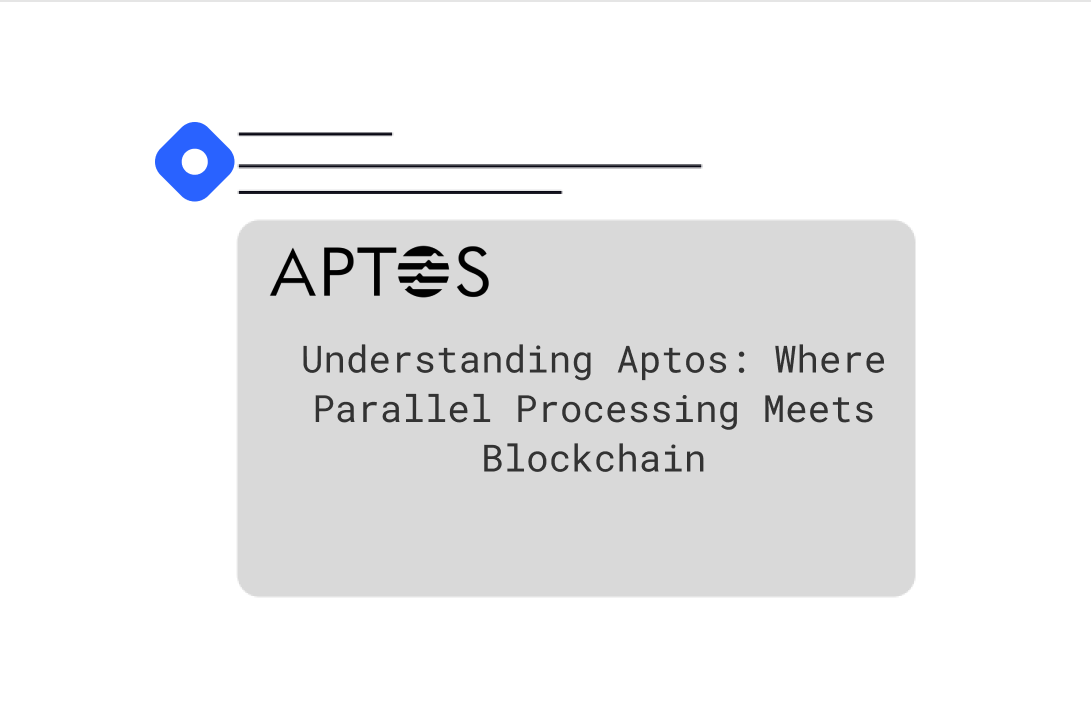Understanding Aptos: Where Parallel Processing Meets Blockchain
 Note Aditya
Note Aditya
Introduction
One of the fastest evolving and innovation rich domains since its inception has been blockchain technology. As platforms like Ethereum and Solana claim to be significant networks, they are still facing the same core issues in blockchain architecture. Here comes Aptos, a forayer into the layer-1 blockchain space in late 2022, offering something fresh to these age-old issues.
At its center, Aptos presents a new parallel execution engine and the Move programming language in order to revolutionize our understanding of blockchain scalability as well as security through decentralization. Developed by an experienced team of developers and researchers, the platform takes a giant step in tackling potential obstacles that have thus far prevented broader blockchain adoption.
The ability for parallel processing of transactions is what differentiates the architecture design utilized within Aptos from most, if not all, existing blockchains today. The platform is touted to offer high throughput without compromising on security or decentralization, which makes it an interesting proposition for developers as well as enterprises.
Before we continue on our understanding of how Aptos works, its ground-breaking features and the reasons why it is an inspiring addition to a blockchain ecosystem, let's deep dive.
What is Aptos & Move
Taking Ethereum as a traditional blockchain as an example, the transactions processing is linear, which means that it is similar to the traffic through a single-lane tunnel. So when the traffic is too heavy, they suffer from congestion and causes high gas fees. This is the area where Aptos, by resorting to the contrast presented previously, approves.
Aptos has become a Blockchain Layer-1 for that purpose, and it has one of the most striking features. It is parallel transaction processing. Just imagine that a simple one-lane has turned into the multi-lane highway and projection of the cars at the same time. Therefore, Aptos like the lane having many traffic moves transactions.
The main mechanism? It's a technology called Block-STM (Software Transactional Memory) - a smart tool that can determine safe transactions that can be executed simultaneously. If at a given time, other blockchains are still dealing with one transaction at a time, Aptos is concurrently processing multiple transactions, with up to a 160,000 transactions per second being the maximum speed on the test network.
But what do you get if you are fast, but you ain't safe, right? However, the solution to that problem is Move - the language that manages Aptos. Move is a language that was designed to secure digital assets. Move can be compared to a bank teller who is the most cautious, in that it'll always double and triple-check before doing the transaction. It wants to keep the digital assets safe and avoids the scenario in which in the case the assets would be treated as resources that can't be copied or deleted by mistake - they can only be moved from one place to another (that's why the name "Move" was chosen).
The thing that sets apart Move from common smart contract approaches is its handling of smart contracts. It's not like other blockchains where even a little insignificant error could produce a billion-dollar damage (remembering the DAO hack); meanwhile, Move's integrated safety mechanisms identify numerous faults in programming before they can cause any problem. It's like a safety net that things can get caught onto that problems don't get out of the way.
Aptos one more perfect aspect is the accomplishment of consensus through a custom-made PoS system known as AptosBFT in a public ledger. The older protocols usually divide into several different versions (called fork) but in the case of Aptos, the same source of truth is always maintained. Transactions are, in the case of Aptos, confirmed, and then they become immutable – that's it, no longer waiting for block confirmations unlike Bitcoin or Ethereum. Thanks to this mix of parallel processing, the Move language, and AptosBFT, Aptos Blockchain is one of the most technologically advanced blockchains at present. It's not just a competition for speed or security; it essentially changes the basic principles of how a blockchain should work.
Inside Aptos Consensus
The heart of Aptos resides in its innovative consensus protocol known as AptosBFT (Byzantine Fault Tolerance), which is used together with block-STM for parallel processing. This merger makes it possible for Aptos to reach high throughput with a view to strong security and full decentralization, with the profit-sharing of users maintained.
How Block-STM Works
Let's break down the process step by step:
- Transaction Batching
Incoming transactions are grouped into batches
Each batch is analyzed for potential dependencies
Transactions are tagged with read and write sets based on the accounts and resources they'll interact with
- Speculative Execution
Multiple transactions are executed in parallel
Each transaction works on its own version of the data
The system maintains a versioned data structure for all accessed resources
Changes are initially kept in local memory without affecting the global state
- Validation Phase
For each transaction T:
- Track all read operations (read set)
- Record all write operations (write set)
- Monitor dependencies between transactions
- Detect any conflicts with concurrent transactions
- Conflict Resolution
If two transactions try to modify the same resource:
The system detects the conflict through version numbers
The later transaction is aborted and restarted
Only the conflicting transactions are retried, not the entire batch
- Commitment Phase
Successfully validated transactions are committed to the blockchain
State changes become permanent
New resource versions are published
Real world Example:
Let's look at a real-world example to understand how Block-STM handles parallel transactions. Imagine we have four different people trying to send APT tokens at roughly the same time. Alice wants to send 10 APT to Bob, while Charlie is sending 5 APT to Dave. At the same time, Bob (who's about to receive tokens from Alice) wants to send 2 APT to Eve, and Frank is sending 1 APT to Grace.
Traditional Processing:
Step 1: Process T1
Step 2: Wait for T1 to complete
Step 3: Process T2
Step 4: Wait for T2 to complete
(and so on...)
Block-STM Processing:
Parallel Execution:
- T1 and T2 start simultaneously (no shared accounts)
- T3 waits for T1 (depends on Bob's balance)
- T4 starts immediately (independent transaction)
AptosBFT: The Backbone of Consensus and Security
AptosBFT is Aptos' innovative consensus protocol that builds on the classical Byzantine Fault Tolerance (BFT) model. Let's dive deep into how this system ensures network security and transaction finality.
Core Components of AptosBFT
- Core Components
Selection Criteria:
- Stake-weighted random selection
- Reputation score consideration
- Historical performance metrics
- Active validator set monitoring
- Rund Structure Each consensus round consists of:
Leader proposal phase
Vote collection phase
Commit phase
Synchronization phase
Detailed Workflow:
- Leader Proposal Phase
Step 1: Leader Selection
- Current round leader is determined
- Stake-weighted probability of selection
- Leader's reputation checked
Step 2: Block Creation
- Leader collects pending transactions
- Orders transactions based on priority
- Creates block proposal with metadata
- Signs the proposal with leader's key
Step 3: Proposal Broadcasting
- Block proposal sent to all validators
- Includes proof of leadership
- Timestamp and round information
- Vote Collection Phase
Step 1: Validator Verification
- Validators check leader's proof
- Verify transaction ordering
- Validate block metadata
Step 2: Voting Process
- Each validator signs their vote
- Votes include validator's stake weight
- Timeout monitoring begins
Step 3: Vote Aggregation
- Votes are collected and counted
- Stake weight is calculated
- Progress towards 2/3 majority tracked
- Commit Phase
When votes reach >2/3 stake weight:
- Block is marked as committed
- All validators execute transactions
- State updates are applied
- New block is added to chain
Safety Mechanisms:
Round Timeouts
Pacemaker System
Ensures network synchronization
Handles round advances
Manages timeout procedures
- Safety Rules
Key Safety Features:
- Double vote prevention
- Fork detection and resolution
- Byzantine fault tolerance up to f<n/3
- Stake-weighted voting power
APT Token
APT tokens are a fundamental part of the Aptos blockchain, which officially launched its mainnet on October 17, 2022. Designed to enhance the efficiency and security of decentralized applications, APT serves several essential functions within the ecosystem. With a total supply capped at 1 billion tokens, the distribution strategy is carefully crafted to foster community engagement and long-term sustainability. 51% of the tokens are allocated to the community, ensuring that users have a significant stake in governance decisions. Meanwhile, 19% goes to core contributors who are vital to the project's development, 16.5% is reserved for the Aptos Foundation, and 13.48% is set aside for investors.
The APT token is not just a currency; it plays a crucial role in transaction fees, governance voting, and staking within the network. Token holders can participate in shaping the future of Aptos by voting on important protocol upgrades and changes, making it a truly community-driven project.Aptos aims for impressive performance, targeting up to 160,000 transactions per second (TPS) with sub-second finality. This ambitious goal is supported by innovative technologies like Block-STM, which allows for parallel execution of transactions, and the AptosBFT consensus mechanism that ensures secure and reliable transaction validation.
Conclusion
Aptos, developed by a team of experts from top institutions, is poised to make a significant impact in the blockchain space. With a strong foundation in innovative technology and a commitment to community engagement, expectations are high for this project. The Aptos team has already demonstrated impressive progress, particularly in addressing the challenges of scalability and efficiency.
The unique architecture of the Aptos blockchain, leveraging techniques like Block-STM and AptosBFT, enables it to handle a remarkable transaction throughput while ensuring secure and rapid consensus. This means users can engage with the platform seamlessly, enjoying low fees and fast transaction times.
As Aptos continues to evolve, it stands out as a promising contender in the quest to enhance decentralized applications, providing a robust framework that could reshape the future of blockchain technology. With its ambitious goals and dedicated community, Aptos is well-positioned to become a leader in the industry.
Aptos is poised to lead the next wave of blockchain innovation, making it an exciting project to follow as it unfolds.
Subscribe to my newsletter
Read articles from Note Aditya directly inside your inbox. Subscribe to the newsletter, and don't miss out.
Written by
